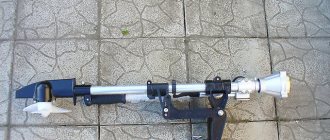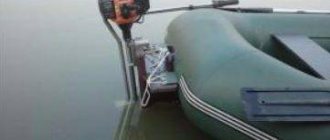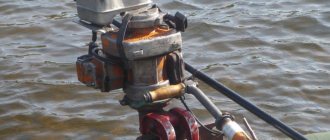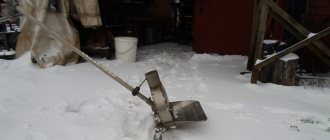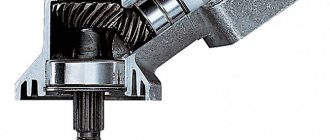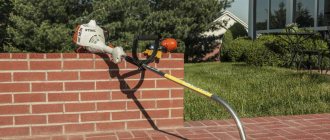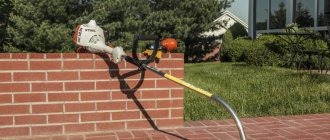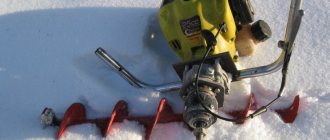Many avid fishermen have repeatedly thought about how to convert an ordinary rubber boat into a motorized watercraft. This is much easier to do than it seems - all you need to do is install a boat motor from a brush cutter on it. We’ll talk about possible methods and nuances of modifying the engine for its installation on a boat in more detail.
Required materials and tools
To convert a trimmer into a boat motor, you need to prepare the following materials:
- a lawn mower with a power of at least 2.2 kW (3 hp);
- a sheet of stainless steel or duralumin with a thickness of 2 mm and dimensions of at least 10x3 cm;
- a steel rod with a length equal to the length of the straight part of the trimmer rod;
- tap for thread cutting. The diameter must correspond to the diameter of the metal rod;
- bicycle hand brake handle
- a clamp for fixing the trimmer on the stern of the boat.
It is convenient to use the bodies of old manual meat grinders as fasteners. After sawing off the top of the meat grinder, a reliable clamp remains, to which you can easily weld or secure the engine with screw connections.
The tools you will need are:
Hacksaw for metal
Drill/driver
Set of wrenches
Tap for cutting threads on steel rod
A welding machine will also come in handy. Most connections of metal assemblies do not involve further disassembly, so it is faster and more reliable to secure the metal by welding than to drill and adjust holes for screw connections.
Features of making a jet motor for a boat with your own hands
If you want to make a high-quality water jet engine, then the Veterok brand motor may be the best base motor. There is nothing special about this, since this particular motor is equipped with all the necessary spare elements that may be needed during the engine manufacturing process. You can purchase it in almost every fishing store or on the Internet.
After the purchased base motor is upgraded, the weight of the jet engine will be increased by literally 1 kg, which is not significant for boats of any type. If the motor is manufactured correctly, it will subsequently be able to accelerate the boat to 25-30 km/h with a boat load capacity of 450 kg. In order to create a jet engine from a base motor, you need to purchase the following additional elements:
- motor of a special type Veterok, which is equipped with a flange;
- water collector and its development;
- rectifier gearbox;
- welding machine;
- hub;
- waterproof glue;
- fittings;
- engine drawings and diagrams.
An important nuance before making a homemade motor is that you need to approach the preparation process as responsibly as possible. With an irresponsible approach, the motor can fail very quickly.
When choosing all the components, it is important to choose only reliable ones so that the motor works properly.
To ensure maneuverability on the surface of the water and the so-called maneuverability of the boat in the future, a special recess must be made in the water collector. It also allows you to reduce hydrodynamic resistance. This can only be done due to the fact that the leading edge, located in the upper part, is located 35 mm higher than the level of the boat bottom.
To assemble the motor yourself, you need to have a very ordinary gearbox. It must be secured to the engine using a flange. After this action, you should take a metal blank in your hands, on which you need to draw a scan of the water collector, the so-called shell and blades in the amount of 6 pieces.
Using hybrid rollers and a file, it is necessary to produce workpieces that will have the most correct shape. To do this, you can use a mandrel or do this process manually. In order to connect the transverse and longitudinal seams of the water jet chamber and drainage system, welding work begins. Do not forget that the design of the water cannon must also have a hub located on the very boss of the finished product.
Once the water cannon is completely ready, its weight should be about 20 kg. Drawings of water cannons of this type are very rare on sale. Therefore, you should create it yourself or find it on the Internet.
Step-by-step instruction
All work is divided into several stages:
- Preparing the propeller shaft.
To do this, the rod is disconnected from the trimmer body, the bushings that play the role of sliding bearings are unscrewed from it, and the flexible shaft is removed. Then the curved lower part is cut off from the rod. This method will no longer allow you to return the gas trimmer to its original state. Therefore, if you plan to use the trimmer for its intended purpose in the future, then you should not cut the rod. It can be replaced with a piece of stainless steel pipe of suitable length. It is desirable that its diameter matches the diameter of the rod. This will allow you to use complete bushings and attach the shaft to the engine housing. - A steel rod is inserted into the rod, and bushings are installed at its ends.
- The resulting structure is attached to the motor shaft. The most reliable connection is welding. If it is necessary to maintain the ability to disassemble this unit, threaded couplings and adapters are used.
- Using clamps, the engine is mounted on the transom of the boat. Alternatively, you can use durable steel clamps attached to the boat's stiffening elements with self-tapping screws.
Expert opinionTorsunov Pavel Maksimovich
When fixing the engine, it is advisable to use gaskets from an old tire between it and the fastening elements. This will reduce noise and dampen some vibrations.
- Using a standard mount or adapters, the rod is connected to the engine.
- A screw is being made.
To do this, the contour of the propeller is cut out of a sheet of metal, and the resulting blades are bent as necessary. A hole is drilled in the center of the screw for a steel rod. Then the propeller is fixed to the propeller shaft with nuts or welding. It is difficult to determine the optimal shape of a propeller by eye. It is better to download one of the options you like from the network in advance and bend the blades according to its requirements. Two-blade propellers are easier to manufacture and center than three-blade propellers. Therefore, for the first experiments, it is wiser to focus on the option with two blades. With a propeller diameter of about 100 mm and an engine power of 3 hp. such a design can propel a boat with a total mass of 120-150 kg. - A bicycle brake handle is screwed close to the engine. It will act as the engine throttle handle.
- The throttle cable is connected to the bicycle brake handle.
The final stage is to check the performance of the resulting boat propulsion system.
Tuning of external parts of the Urals
Here the direction of tuning depends on the style in which you want to make the motorcycle. Typically, owners choose classic custom options.
Most often, the appearance of the Urals undergoes the following changes:
- replacement of fenders, handles, mirrors, fairings, seats, footrests;
- chrome plating of parts for more shine;
- changing the shape of the fuel tank and steering wheel;
- making a new muffler.
Ural - cafe racer
One of the simplest and most popular custom styles. During the remodeling process, unnecessary parts are removed from the Urals, and old heavy ones are replaced with lightweight and stylish ones.
The tail of the motorcycle is digested to create an aerodynamic hump, and a new seat is installed. The wheels are also being updated: they should be spoked, with light rims and road tires.
Read more about how to make Cafe Racer here:
no images were found
Ural - bobber
Also quite a popular area of customization among the owners of the Urals. In this case, the rear part of the frame is modified and the rear shock absorbers are removed. The tank is replaced with a smaller version of it, and a small single seat is also made.
In principle, it’s also nothing particularly complicated, the only thing is that you’ll have to tinker with altering the motorcycle frame. And it is made of durable low-carbon steel and therefore is quite difficult to overcook.
Read more about building a Bobber with your own hands here:
no images were found
Ural - chopper
This is the most complex and expensive type of tuning of the Urals with your own hands. First, you will have to make a completely new frame. Most often, ordinary water pipes with thick walls are used for this.
You will have to tinker with finding and installing a wide rear wheel, at least 150 mm. The exhaust pipe will also need to be redesigned to make it look stylish.
The chopper driver must sit imposingly, so the footpegs will need to be moved forward, and the location of the motorcycle controls will need to be changed. And of course, make a large and wide steering wheel.
The last step will be to ensure that all parts of the motorcycle are covered with chrome and shine dazzlingly.
For an example of drawings for converting a chopper, see here:
no images were found
Questions and answers
Why can't you keep the standard flexible shaft in the rod?
It is necessary to replace the flexible shaft with a steel pin due to the high load on such a torque transmission system. Under load, the flexible shaft will not be able to rotate evenly due to twisting, and the boat will move jerkily. In addition, in this mode, the standard trimmer shaft will not work for very long.
Why is a factory screw from a store better than a homemade one?
The purchased screw has a precise shape, allowing for maximum efficiency of the entire structure. In addition, boat propellers are often sold complete with the necessary fasteners (bushings). This simplifies the conversion of the trimmer into a boat engine, but requires certain financial investments.
Is it possible to use a screw larger than 100 mm in diameter?
Yes, this is possible, and it will even be possible to achieve greater speed. However, in this case, the design will have to be retrofitted with a gearbox, since the power of the trimmer engine is not enough to rotate a large propeller. You can use a gearbox from a trimmer head. To secure it you will need a couple more clamps. To extend the life of the gearbox, it is necessary to ensure the constant presence of lubricant in its housing.
How to properly use a boat motor from a brush cutter?
When using a trimmer like a boat motor, the operator needs to constantly monitor the condition of the engine and give it time to cool down.
In addition, the following will help extend the service life of a boat motor using a trimmer:
- checking all the fasteners present in the device - before each start of the engine, you need to carefully inspect the clamps that hold the engine elements from the trimmer;
- refueling the engine from the trimmer only with the gasoline and oil that was used to operate the brush cutter;
- timely cleaning and replacement of the engine air and fuel filters;
- regular checking and timely replacement of the fuel pump;
- inspection and, if necessary, replacement of the spark plug.
Regular ventilation of its standard cylinder will also help to extend the life of a boat internal combustion engine from a trimmer. To do this, you need to unscrew the spark plug approximately once every 2 months, and rarely pull out the starter cable 4-5 times. After the procedure, the spark plug can be screwed back into place and continue operating the engine.
Homemade muffler for chainsaw.
How to make a silencer for a 2-stroke engine with their own hands. In a 2-stroke engine there is a muffler
plays one of the important ones.
Gasoline - any pure high-octane gasoline (with a number of 92 and higher, with a density in the range of 750-770 kg/m3).
The purity of gasoline must be: mechanical - to settle and store gasoline for use not in metal containers and for no longer than 1 (one) month, otherwise it will oxidize and lose its properties; chemical - impurities and additives should not be present (they have different rates, degrees and temperatures of combustion). Old gasoline turns yellow or red, and the impurities have a strong smell of bitterness (for example, creosote) or acid (for example, methyl alcohol). The proportion of the fuel mixture is 1:50 (2%) or 20 ml/cm3 of oil per 1 liter of gasoline. For example, pour half a measure of gasoline into a transparent plastic bottle (1 l), then use a medical syringe (20 ml/cm3) to introduce two-stroke oil and mix, add gasoline and mix thoroughly. If the quality of gasoline is questionable or the working conditions are difficult, then the amount of oil can be increased to 22-25 ml/cm3. Muffler for pneumatics - how to make your own muffler. Shake the mixture before each filling! Store the resulting fuel for no more than two weeks! If the color of the mixture has changed (from sea green to, for example, brown), then it is not recommended to use it!
Ready set of nozzles
At the moment, there are ready-made attachments for lawn mowers that allow you to convert your mower into a motor for a boat with minimal effort.
The attachment already has a ready-made solution for attaching it to the trimmer’s gasoline engine.
Also attached to the rod is a control handle with a muffler button. The throttle handle is made in the likeness of a bicycle handle (meaning a bicycle with a gear change) and has a ratchet that locks the selected position.
This set even includes a special clamp designed to secure the entire structure to the boat (on the transom of the vessel).
The trimmer attachment can be assembled without difficulty, since its design is very simple. All that remains is:
- connect the throttle cable to the engine;
- connect the muffler wires, and the unit is ready for operation.
If you read reviews on the Internet about this device, they are mostly positive.
The cost of this trimmer attachment ranges around 5,000 rubles.
Benefits of using a trimmer
First of all, it is worth considering the main advantages of using a trimmer for making a boat motor:
- the cost of a trimmer is significantly lower than the cost of a finished motor for a boat;
- very economical fuel consumption;
- reliability during operation;
- light weight, which is very important when using a trimmer on rubber boats;
- built-in translucent fuel tank, through the walls of which the gasoline level is clearly visible;
- fairly sealed design;
- a rigid shaft is installed in the rod;
- To control the unit, there are ready-made elements (starter and gas).
All these qualities of the device put it in first place, if we take into account other modification options. So, in order for the trimmer (requires a power of 0.7 kW) to turn into a full-fledged boat motor, you need to purchase a special set of attachments for it or make them yourself.
see also
Comments 55
what material is the exhaust hose made of?
This motor has been gone for a long time, but the hose is metal, some kind of corrugation
Probably I didn’t finish looking, when I made one for myself, a 5.4 l/s trimmer for a single-seater boat - it was something. During the test, even the propeller blade flew off, it was scary.
Well done, I just look at your rigidly welded leg fastening, but it should be able to tip over, like on a PLM.
There, the entire motor and transom capsized, but this motor is long gone, as is the boat. But the recording remains here)
Original! Song for beginners! Even if it's loud
How did you seal the gearbox? there are a lot of holes for purging, through all of them water will flow into the area of the shaft bearing
It's full of grease and that's it, the gearbox overwintered well, we checked it the other day, everything spins and doesn't whistle.
Does the deadwood pipe go directly to the shaft bearing, or what? As I understand it, it prevents water from entering in this way. I have a gearbox from a 230 angle grinder and there the bearing will thresh just in combination with water (the upper one of the input shaft)
It would be interesting to see tests on water... In short, a video on the site
I think there are videos on YouTube. And so, in short, “yells and swims”)...
interesting solution with making a screw...
There was simply no other, and those who sell them rotate in the other direction
theoretically, it was possible to take a propeller of a “different rotation” and set it to the airplane’s, i.e. not pushing, but pulling. but that's just a side note. I haven't tried it myself.
Theoretically yes, but we scored)
Aren't you afraid of seating the piston from splashes? I was just mowing through the reeds myself, and the piston burst from the splashes.
You're swimming and there's no splashing on the motor.
anyway, it wouldn’t hurt to adapt the snail to the air intake.
What is an electric motor for a boat?
As the name suggests, unlike a fuel-powered boat motor, an electric motor runs on energy transferred to it from a power source. A rechargeable battery (AB) is used as such a source, so the second name for an electric motor is a rechargeable boat motor. At the same time, manufacturers produce equipment compatible with voltages of 12, 24 and 36 V, respectively, the higher this indicator, the greater the performance of the engine.
The design of electric boat motors is quite simple. The device is equipped with a control panel, tiller, connecting rod, motor, propeller and rotor. In this case, the structure is essentially divided into 2 parts: surface (tiller, control panel) and underwater (engine, propeller, rotor). And they are connected by a rod, the length of which is freely adjustable, which gives great advantages when moving and fishing in shallow water. Such a rod is made of impact-resistant metals, so that it is not afraid of collisions between the vessel and any obstacles.
The electric boat motor starts working immediately after pressing the switch once. Thus, the time required to start fuel units is significantly saved. Typically, an electric motor for boats has 4-5 speeds for forward movement and another 3 gears for reverse. In this case, the speeds are switched manually or in foot mode. This is an important factor, because, for example, fishermen need both free hands and full control of the vessel.
Thus, the design of electric motors gives them a number of advantages over fuel-powered devices. For example, an electric motor for an inflatable boat allows the vessel to move smoothly on bodies of water without scaring away the fish with the noisy operation of the engine. The same applies to plastic boats, rubber boats and other small vessels. In general, watercraft equipped with an outboard electric motor are used for:
- trolling;
- boat trips;
- spinning fishing;
- moving through bodies of water overgrown with vegetation;
- steering and maneuverability in shallow water.
Such motors also perform well in terms of power characteristics. However, they are somewhat specific, so we will consider the speed indicators of electric motors separately.
Thrust and speed of a boat with an electric motor
Unlike fuel units, the power of electric motors on a boat is measured not in horsepower and kilowatts, but using a special characteristic - thrust. The term “thrust” refers to the maximum force that a given electric outboard motor is capable of developing during operation. Moreover, the size and rotation speed of the engine propeller, which does the main work, are of decisive importance here.
Thrust is measured based on calculations of the vessel's speed and water or wind resistance and is most often expressed in pounds (to convert to kg, multiply the pound indicator by 0.45). At the same time, the displacement and dimensions of the boat are directly related to the tractive effort. The more massive the craft, the more thrust the motor should have. Moreover, for calculations the max. boat weight, i.e. weight of the vessel + equipment + cargo + passengers.
But then a treacherous question arises for shipowners: if you put a powerful electric motor for a yacht on a small boat, will its speed increase? Unfortunately, savvy fans of high-speed travel will have to be disappointed: an increase in traction is by no means equivalent to an increase in speed. The thing is that a boat with an electric motor is partially submerged and kept afloat by the force of Archimedes. And according to the laws of physics, it is virtually impossible to develop high speed overcoming such dense water resistance. So the vessel will definitely not move above the initial speed of 7-15 km/h (depending on the dimensions).
Principle of operation
The trimmer has a higher rotation speed of the blades, which makes it possible to move through the water at a higher speed, which will allow you to start fishing faster than with a motor. Everyone has seen how a trimmer works - how it cuts a lawn and ordinary grass, but here, its blades are turned in the other direction and at the same time, it performs the function of the most economical motor.
But if the trimmer is lower, the speed will be lower. But the main disadvantage of trimmers compared to ordinary boat motors is that they are very loud and should not be used fully if you do not want to scare away the fish.
Models with two-stroke engines
You can make a boat motor with a two-stroke engine with your own hands only if you use a crankshaft with a diameter of at least 60 mm. Otherwise, it will not withstand the load. In this case, you can select a regular flywheel. In this case, the fuel pump must withstand a maximum pressure of at least 3 bar. Experts advise installing rocker arms only on three valves. The thermostat can be mounted on boat motors (homemade) if desired.
Exhaust valves in the system are most often installed in aluminum. There are a variety of cooling devices available today. The simplest option is considered to be a water modification. To do this, intakes should be provided in advance in the pallet. The pushrods above the engine should be installed last. The deadwood for the two-stroke modification is suitable with a 120 mm rod.
Assembling the sawmill
When building houses and other structures from logs, it is often necessary to cut them into beams. A chainsaw sawmill allows you to do this as efficiently as possible with good cutting accuracy. At the same time, the instrument itself does not require any modifications. It is simply fixed in a frame made, for example, from metal corners or profile pipes. The processed logs are placed on guides. The entire structure is shown in the diagram below.
In a homemade sawmill, the log is not moved: a carriage with a saw moves, fixed at the required height (depending on the thickness of the lumber) with four screws. Due to the fact that the frame moves accurately, sawing occurs carefully and the cut is smooth. The created device (a version of it is shown in the photo below) also allows you to saw boards and prepare firewood without any problems.
